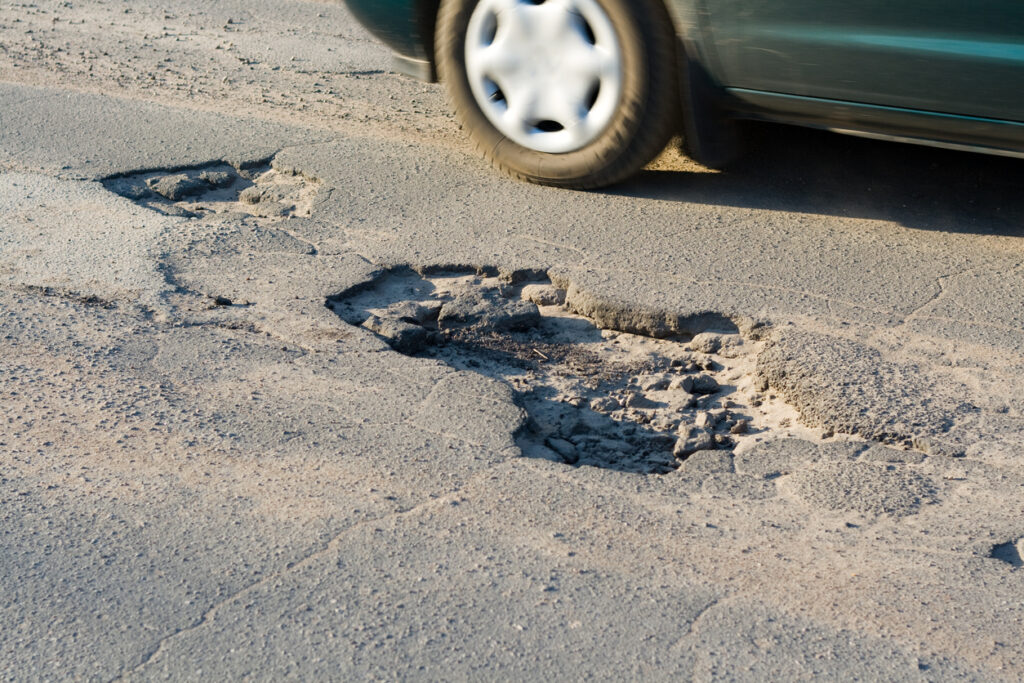
This week’s question comes from Jennifer in Mill Valley, who writes,
Q: After this year’s rainy winter, new potholes seem to be appearing daily. After I predictably blew a tire a few weeks ago, I thought I’d write a note to the city asking for reimbursement of the cost of replacing my tire. I just received a letter back stating that my claim, which was for less than $150, had been denied. I’m not going to pursue legal action over such a small sum, but I’m irked that the city is able to skirt responsibility for probably hundreds of similar cases, when their roads don’t seem to stand up to the weather.
A: Thank you for your question, Jennifer, and you have my sympathy in this frustrating and all-too-common situation. Potholes are indeed more prevalent after heavy rains, as water seeps through pre-existing cracks in the asphalt and settles underneath, making the ground more susceptible to erosion and sagging as vehicles travel over top. And while this seasonal occurrence seems predictable enough, a city is often not held liable for damage caused by any particular pothole.
A city, like any other property owner, is charged with maintaining their premises in a reasonably safe condition. However, reasonable does not mean perfect and maintenance is not expected to be instantaneous. For example, a deviation in a road’s level measuring under one inch will generally be deemed “trivial” as a matter of law and, therefore, not deemed to be the city’s responsibility. As such, many damages resulting from potholes may simply not fall within any property owner’s scope of liability.
As discussed in previous columns, California Government Code §§ 830 et seq. lays out the rules for liability stemming from any “dangerous condition of public property,” defined as a condition that creates a substantial risk of injury when such property is used with due care in a reasonably foreseeable manner. Cal. Gov. Code § 830.2. Courts have held these conditions to include premises that are “physically damaged, deteriorated, or defective in such a way as to foreseeably endanger those using the property itself.” Cordova v. City of Los Angeles (2015). This description would seem to clearly implicate potholes that make driving on city roads dangerous.
However, the existence of a non-trivial dangerous condition itself does not mean that a city is liable for damages it causes: the “dangerous conditions of public property” doctrine further requires that the city have either (1) caused it via negligent conduct, e.g. during roadwork, or (2) were actually aware of it (actual notice), or should have been under the circumstances (constructive notice), and had sufficient time to make appropriate repairs. Cal. Gov. Code § 835. Conduct is deemed to be negligent if the actor unreasonably failed to exercise due care, determined by weighing the probability and gravity of potential injury against the practicability and cost of alternative action. Cal. Gov. Code § 835.4. A determination of constructive notice may involve analysis of the dangerous condition’s severity and visibility, as well as the frequency of traffic to the location and occurrence of any previous adverse events, among other factors. Therefore, unless the pothole was specifically and unreasonably caused by a city itself or lay conspicuous and unrepaired for an unreasonable amount of time, the city will still not be held liable for any damages due to even the worst pothole on the road.
Even if all these statutory requirements are met, a city may still raise a number of defenses to defeat liability. It may argue that it had exercised due care by blocking off the location or posting warning signs to prevent the vehicles from making contact with the pothole; alternatively, it may argue that the pothole was in fact so “open and obvious” that no such blockade or warning sign was necessary and the damage was solely attributable to the driver’s inattention to road conditions. A city may claim “design immunity”; that is, it should not be held liable for risks incidental to a previously-approved road design, where the approval was made in the discretion of an appropriate decision-making body based on substantial evidence of the design’s reasonableness. Cal. Gov. Code § 830.6.
As you can see, your frustration with the city’s response is quite likely not due to the obstinance of the city’s legal department, but rather the law itself. However, it is still very important for you to report poor road conditions! Not only will reporting increase the chance that the condition will be promptly repaired, it will also put the city on actual notice of the defect, increasing the chance that it will be held liable for future damages if appropriate repairs are not made. There is a good chance that your reporting will help prevent damage to someone else’s vehicle or even someone being seriously injured.










